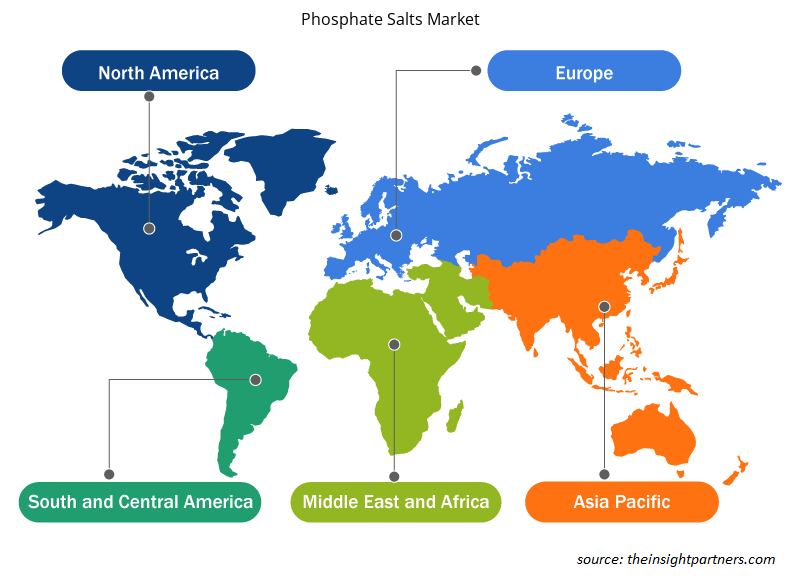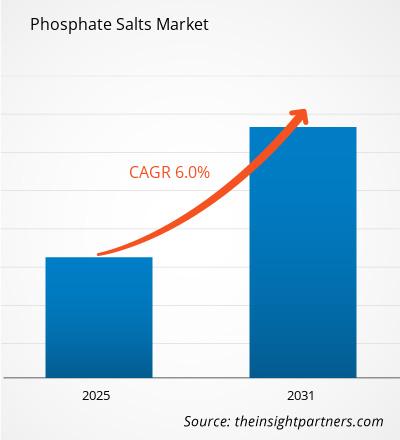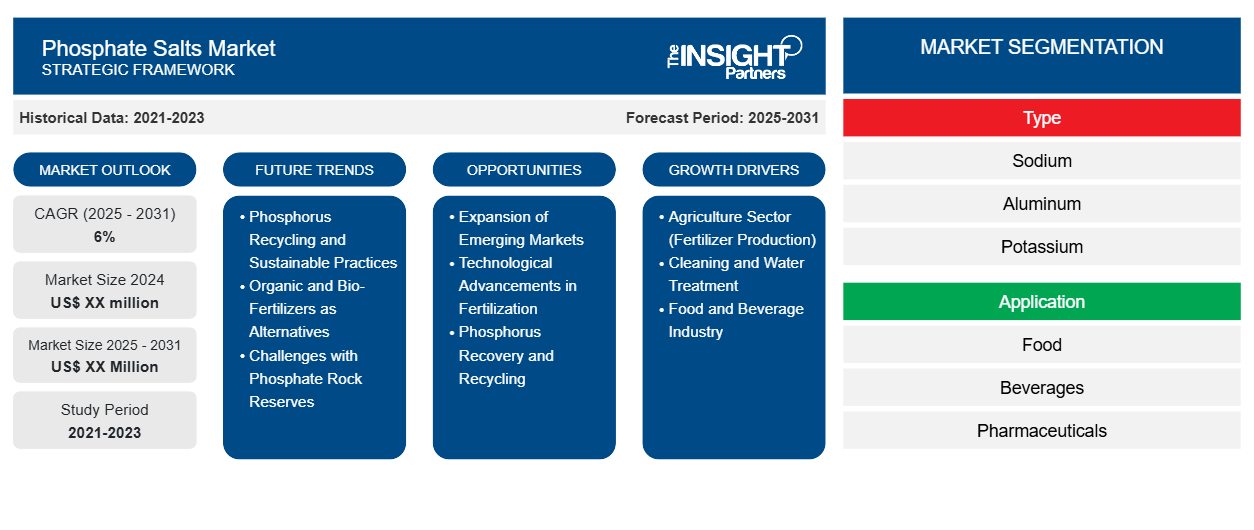磷酸盐市场预计在 2023 年至 2031 年期间的复合年增长率为 6%,市场规模将从 2023 年的 XX 百万美元扩大到 2031 年的 XX 百万美元。
磷酸盐市场报告按类型(钠、铝、钾、钙、铵等)细分。市场根据应用细分 [食品(乳制品、烘焙产品、肉类家禽和海鲜等)、饮料、药品、水处理、农业、纺织品、油漆和涂料、洗涤剂等]。全球分析进一步细分为区域和主要国家。范围涵盖所有关键细分市场的全球、区域和国家层面的市场规模和预测。该报告以美元为单位提供了上述分析、细分市场、地区和国家的价值。报告涵盖市场趋势以及市场动态,如驱动因素、限制因素和关键机会。报告还涵盖行业格局和竞争分析,包括市场集中度、热图分析、知名参与者和市场最新发展。
报告目的
The Insight Partners 的《磷酸盐市场》报告旨在描述当前形势和未来增长、主要驱动因素、挑战和机遇。这将为各种业务利益相关者提供见解,例如:
- 技术提供商/制造商:了解不断变化的市场动态并了解潜在的增长机会,从而能够做出明智的战略决策。
- 投资者:对市场增长率、市场财务预测以及整个价值链中存在的机会进行全面的趋势分析。
- 监管机构:监管市场政策和警察活动,旨在最大限度地减少滥用行为,维护投资者的信任和信心,维护市场的完整性和稳定性。
磷酸盐市场细分
类型
- 钠
- 铝
- 钾
- 钙
- 铵
应用
- 食物
- 饮料
- 药品
- 水处理
- 农业
- 纺织品
- 油漆和涂料
- 清洁剂
定制此报告以满足您的需求
您可以免费定制任何报告,包括本报告的部分内容、国家级分析、Excel 数据包,以及为初创企业和大学提供优惠和折扣
-
获取此报告的关键市场趋势。这个免费样品将包括数据分析,从市场趋势到估计和预测。
磷酸盐市场增长动力
- 农业部门(化肥生产):农业部门对磷酸盐的需求量最大,主要用于生产磷酸盐基化肥。磷通常被称为仅次于氮的第二大作物养分,在植物生长中起着至关重要的作用,而磷酸盐则通过提高土壤肥力来提高和维持作物产量。由于全球人口快速增长,维持生计需要更多的食物,这意味着农业生产力的提高。全球农业的增长,特别是在世界发展中地区,是促进磷酸盐市场增长的因素之一,因为每个农民都努力生产更多的作物并养活饥饿的人口。
- 清洁和水处理:磷酸盐在此指的是那些可用于各种洗涤剂和清洁剂、水处理和其他工业的物质。它们可用作软水剂、稳定剂和分散剂,以提高产品的有效性。由于发展中经济体的工业化和城市化进程不断加快,以及家用和工业清洁产品的进步,上述因素导致这些行业对磷酸盐的需求增加。在城市发展和工业化过程中,清洁和水处理分别很重要,磷酸盐在工业中的应用市场十分活跃。
- 食品和饮料行业:在食品和饮料行业中,磷酸盐通常以食品防腐剂、质地增强剂和增味剂的形式加入到食品中。它们有助于防止肉类水分流失、改善碳酸饮料的质量并用作包装蛋糕中的发酵粉。加工食品和快餐越来越受消费者欢迎,因此预计食品和饮料行业在不久的将来会使用更多的磷酸盐。
磷酸盐市场未来趋势
- 磷回收和可持续实践:随着世界农业面临损害环境可持续性和资源可用性的问题,对绿色或环保肥料的需求激增。磷酸盐的提取和肥料的制造会对环境产生负面影响,包括但不限于土地侵蚀和水污染。因此,该行业现在正专注于更环保的解决方案,包括制造含有回收磷的无机肥料而不是开采新的磷酸盐矿石,以及改进磷酸盐开采中采用的可持续实践。将废物转化为肥料的技术以及除采矿以外的磷源(例如磷酸盐岩的回收)的改进潜力巨大。
- 有机和生物肥料作为替代品:有机农业实践的增加反过来又增加了对生物和有机肥料的需求,因为这些肥料不使用含有合成磷酸盐的肥料活性成分。有机农业不使用化肥等化学品,因此在很大程度上利用了自然界中发现的并通过有机工艺制成的磷酸盐。这是人们日益希望改变农业实践以更加环保和健康的一部分。随着消费者越来越热衷于有机食品,有机或天然磷酸盐预计将在世界市场尚未开发的领域大受欢迎。
- 磷矿储量面临的挑战:由于人们对磷矿储量减少以及磷矿开采对环境的影响的担忧,磷的回收和再利用变得越来越重要。目前正在进行高级开发,以设计利用废水、污水污泥和农业径流来回收磷的系统。此类绿色项目可减轻环境影响并促进循环经济。可以说,随着磷矿供应变得稀缺,通过回收和再利用磷酸盐行业产品中现有的废料,获得新的磷源也将变得稀缺。
磷酸盐市场机会
- 新兴市场的扩张:随着工业用途的增加,预计亚太、拉丁美洲和非洲等新兴市场的磷酸盐市场将有所增长。许多地区的人口增长率使得农业投资成为必然,而发展农业也更多地使用化肥。此外,工业发展也推动了对磷酸盐的需求,例如清洁剂、水处理和洗发水。制造商可以通过销售价格低廉、可得(如果可能)符合当地需求的本地磷酸盐来打入这些市场。
- 施肥技术进步:由于人们越来越需要更有效、更环保的农业生产过程等因素,施肥技术具有巨大的改进潜力。磷酸盐是这一转变的核心,因为除了精准农业策略(力图节约养分)之外,该行业还专注于生产缓溶颗粒肥料。精心设计磷酸盐,使其能够提高植物的吸收率或降低释放速度,这将最大限度地减少肥料的浪费并最大限度地提高产量,从而为企业在市场上创新新产品创造机会。
- 磷回收和再循环:随着传统磷酸盐开采的环境和环境可持续性问题日益严重,磷回收和再循环投资前景广阔。从废物源中回收磷(例如,从市政污水处理厂和农业径流中恢复磷)将有助于工业减少采矿作业,并鼓励对磷进行可持续管理。这一机会反映了世界在实践循环经济和废物管理方面的努力,从而提供了经济和生态优势。
磷酸盐市场区域洞察
Insight Partners 的分析师已详细解释了预测期内影响磷酸盐市场的区域趋势和因素。本节还讨论了北美、欧洲、亚太地区、中东和非洲以及南美和中美洲的磷酸盐市场细分和地理位置。

- 获取磷酸盐市场的区域具体数据
磷酸盐市场报告范围
| 报告属性 | 细节 |
|---|---|
| 2023 年的市场规模 | XX 百万美元 |
| 2031 年市场规模 | XX 百万美元 |
| 全球复合年增长率(2023 - 2031) | 6% |
| 史料 | 2021-2022 |
| 预测期 | 2024-2031 |
| 涵盖的领域 |
按类型
|
| 覆盖地区和国家 |
北美
|
| 市场领导者和主要公司简介 |
|
磷酸盐市场参与者密度:了解其对业务动态的影响
磷酸盐市场正在快速增长,这得益于终端用户需求的不断增长,而这些需求又源于消费者偏好的不断变化、技术进步以及对产品优势的认识不断提高等因素。随着需求的增加,企业正在扩大其产品范围,进行创新以满足消费者的需求,并利用新兴趋势,从而进一步推动市场增长。
市场参与者密度是指在特定市场或行业内运营的企业或公司的分布情况。它表明在给定市场空间中,相对于其规模或总市场价值,有多少竞争对手(市场参与者)存在。
在磷酸盐市场运营的主要公司有:
- 马赛克公司
- OCP集团
- 欧洲化学集团
- 以色列化学品有限公司
- 纽特瑞恩有限公司
免责声明:上面列出的公司没有按照任何特定顺序排列。

- 了解磷酸盐市场主要参与者概况
主要卖点
- 全面覆盖:报告全面涵盖了磷酸盐市场的产品、服务、类型和最终用户的分析,提供了整体概况。
- 专家分析:报告基于对行业专家和分析师的深入了解而编写。
- 最新信息:该报告涵盖了最新信息和数据趋势,确保了其与业务的相关性。
- 定制选项:此报告可以定制以满足特定客户要求并恰当地适应业务策略。
因此,磷酸盐市场研究报告有助于引领解读和了解行业情景和增长前景。尽管可能存在一些合理的担忧,但本报告的总体优势往往大于劣势。
- 历史分析(2 年)、基准年、预测(7 年)及复合年增长率
- PEST和SWOT分析
- 市场规模、价值/数量 - 全球、区域、国家
- 行业和竞争格局
- Excel 数据集
近期报告
客户评价
购买理由
- 明智的决策
- 了解市场动态
- 竞争分析
- 客户洞察
- 市场预测
- 风险规避
- 战略规划
- 投资论证
- 识别新兴市场
- 优化营销策略
- 提升运营效率
- 顺应监管趋势























 获取免费样品 - 磷酸盐市场
获取免费样品 - 磷酸盐市场